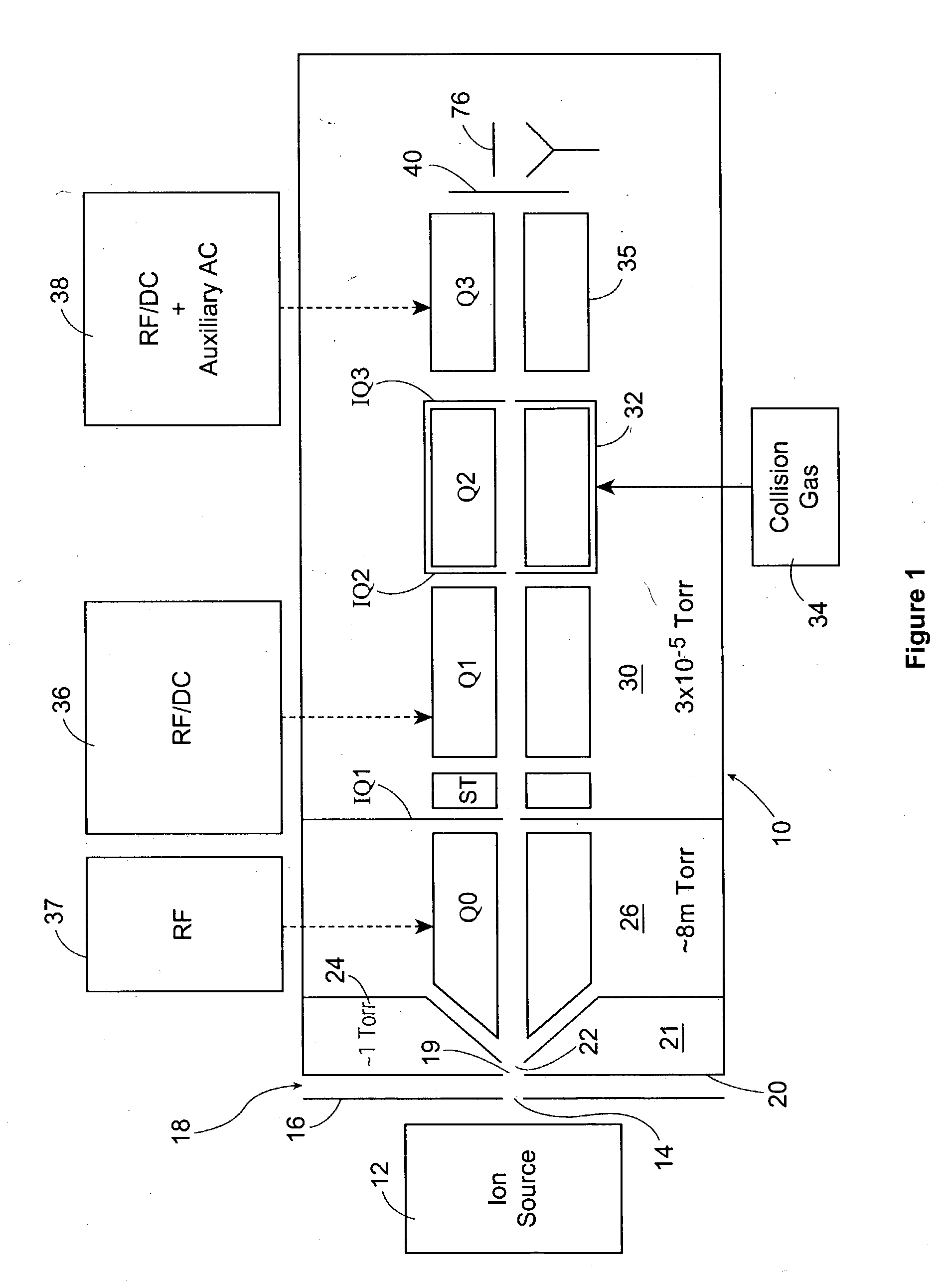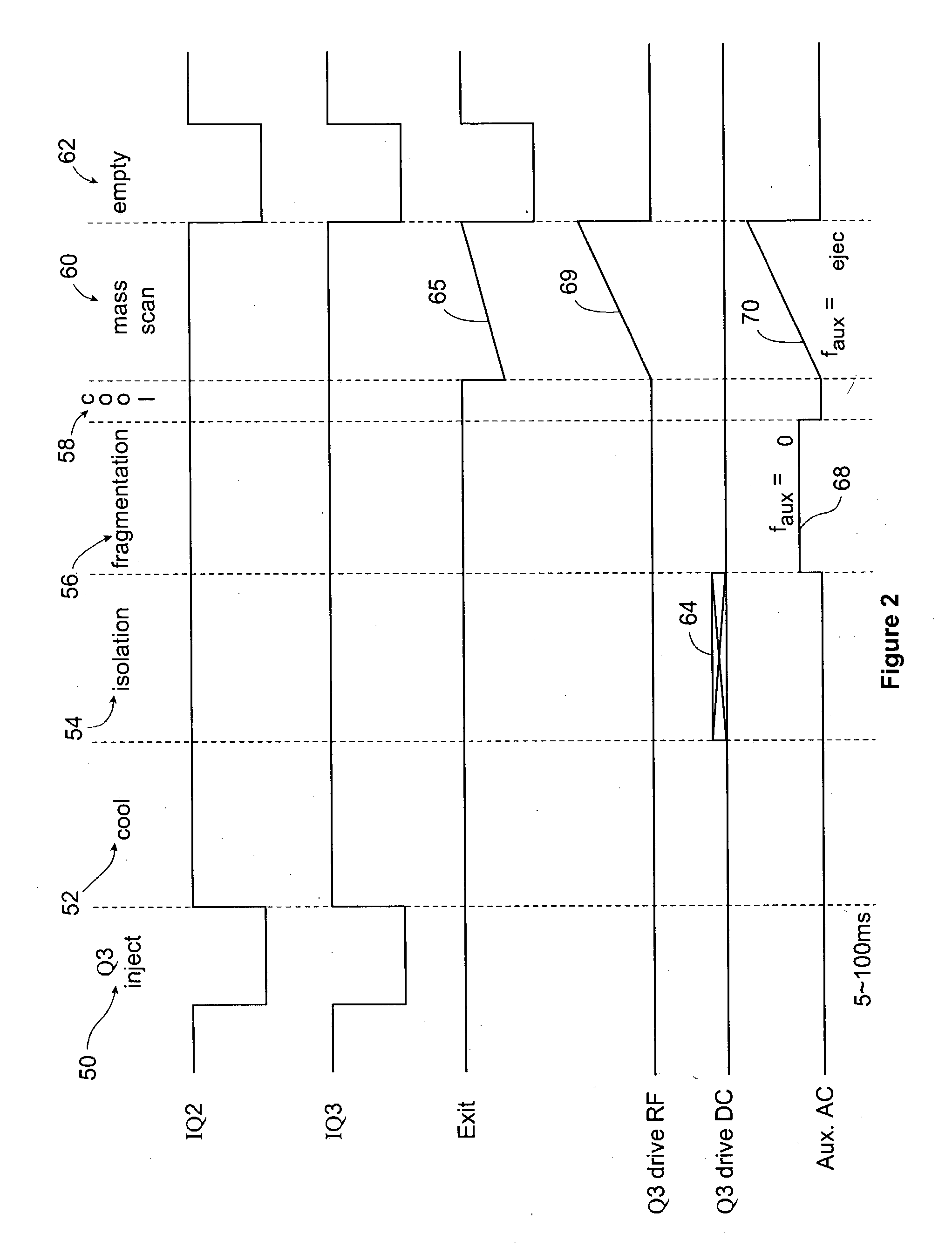Fragmentation of ions by resonant excitation in a high order multipole field, low pressure ion trap
a multi-pole field, ion trap technology, applied in mass spectrometers, separation processes, instruments, etc., can solve the problem of relatively low ability to isolate and fragment a specific ion within the collision cell, and achieve the effect of increasing the fragmentation efficiency, reducing the probability of collision induced dissociation, and dampening the oscillatory motion
- Summary
- Abstract
- Description
- Claims
- Application Information
AI Technical Summary
Benefits of technology
Problems solved by technology
Method used
Image
Examples
first embodiment
[0052] FIG. 1 illustrates a mass spectroscopy apparatus 10 in accordance with a In known manner, the apparatus 10 includes an ion source 12, which may be an electrospray, an ion spray, a corona discharge device or any other known ion source. Ions from the ion source 12 are directed through an aperture 14 in an aperture plate 16. On the other side of the plate 16, there is a curtain gas chamber 18, which is supplied with curtain gas from a source (not shown). The curtain gas can be argon, nitrogen or other inert gas, such as described in U.S. Pat. No. 4,861,988, to Cornell Research Foundation Inc., which also discloses a suitable ion spray device. The contents of this patent are incorporated herein by reference.
[0053] The ions then pass through an orifice 19 in an orifice plate 20 into a differentially pumped vacuum chamber 21. The ions then pass through aperture 22 in a skimmer plate 24 into a second differentially pumped chamber 26. Typically, the pressure in the differentially pu...
second embodiment
[0091] FIG. 14 shows the experimental results of fragmenting the 2722 m / z tuning solution as carried out using the mass spectrometer of the The fragmentation efficiency for the 2272 m / z tuning solution increased when a potential difference of .delta.=160V was applied between the linac electrodes 122 and the quadrupole rods 35'. In these experiments the excitation period was still 200 ms, and fragmentation was carried out using excitation amplitudes of 100, 125 and 170 mV. The line of solid squares 130 show the intensity of the fragments plus parent ions for the 170 mV experiments. At the peak 132 of the 170 mV data 130 (the peak occurring at 60.33 kHz), the fragments represent more than about 85% of the starting parent ions. The remaining parent ions (not shown) represent about 14% of the initial parent ion intensity. This implies a nearly 0% ejection of parent ions during the excitation process.
[0092] The excitation profile for the 170 mV data 132 is slightly distorted and broader...
PUM
| Property | Measurement | Unit |
|---|---|---|
| pressure | aaaaa | aaaaa |
| pressure | aaaaa | aaaaa |
| pressure | aaaaa | aaaaa |
Abstract
Description
Claims
Application Information
 Login to View More
Login to View More - R&D
- Intellectual Property
- Life Sciences
- Materials
- Tech Scout
- Unparalleled Data Quality
- Higher Quality Content
- 60% Fewer Hallucinations
Browse by: Latest US Patents, China's latest patents, Technical Efficacy Thesaurus, Application Domain, Technology Topic, Popular Technical Reports.
© 2025 PatSnap. All rights reserved.Legal|Privacy policy|Modern Slavery Act Transparency Statement|Sitemap|About US| Contact US: help@patsnap.com



